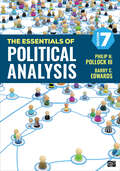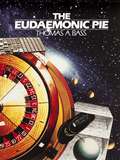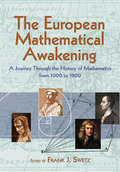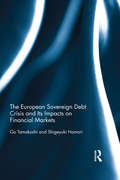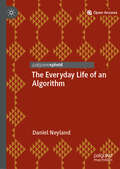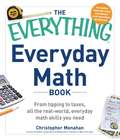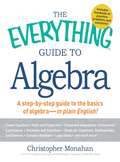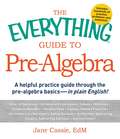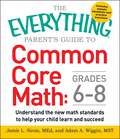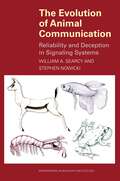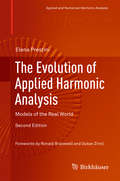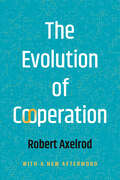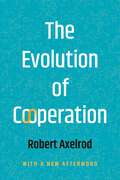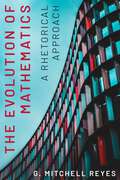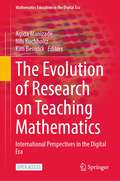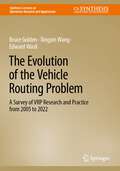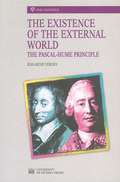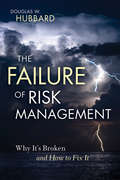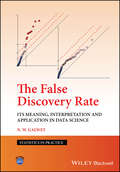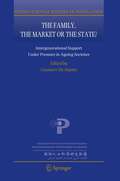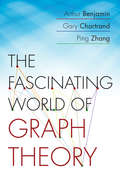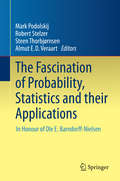- Table View
- List View
The Essentials of Political Analysis
by Philip H. Pollock Barry Clayton EdwardsEquip students with the skills and confidence they need to conduct political analyses and critically assess statistical research. In the Seventh Edition of The Essentials of Political Science, bestselling authors Philip H. Pollock III and Barry C. Edwards build students’ analytic abilities and develop their statistical reasoning with new data, fresh exercises, and clear examples. This brief and reader-friendly guide walks students through the essentials— defining measurement, formulating and testing hypotheses, measuring variables—while using key terms, chapter-opening objectives, over 80 tables and figures, and practical exercises to get them using and applying their new skills. Using Excel, R, SPSS, or STATA? Companion workbooks featuring statistical software instructions and exercises help your students apply their knowledge.
The Eudaemonic Pie
by Thomas A BassThe Eudaemonic Pie is the bizarre true story of how a band of physicists and computer wizards took on Las Vegas.
The European Mathematical Awakening: A Journey Through the History of Mathematics from 1000 to 1800
by Frank J. SwetzAbsorbing and entertaining, these thirty-two articles by distinguished educators offer a reader-friendly introduction to the history of mathematics. The newly corrected and updated essays cover eight centuries of discoveries, ranging from the medieval practice of finger calculus to the pioneering work of Leonhard Euler.Fascinating topics include the geometry behind the windows of Gothic churches, the development of complex numbers, the evolution of algebraic symbolism, and mathematical considerations on the trajectory of a cannon ball. Profiles of historic figures include Leonardo Fibonacci, Johannes Kepler, Isaac Newton, Galileo, the Bernoulli family, and other well- and less-known personalities, including mathematicians of the French Revolution and women in mathematics. Suitable for readers with no background in mathematics, this volume offers an excellent guide for high school students and college undergraduates as well as anyone with an interest in the history of mathematics.
The European Sovereign Debt Crisis and Its Impacts on Financial Markets
by Shigeyuki Hamori Go TamakoshiThe global financial crisis saw many Eurozone countries bearing excessive public debt. This led the government bond yields of some peripheral countries to rise sharply, resulting in the outbreak of the European sovereign debt crisis. The debt crisis is characterized by its immediate spread from Greece, the country of origin, to its neighbouring countries and the connection between the Eurozone banking sector and the public sector debt. Addressing these interesting features, this book sheds light on the impacts of the crisis on various financial markets in Europe. This book is among the first to conduct a thorough empirical analysis of the European sovereign debt crisis. It analyses, using advanced econometric methodologies, why the crisis escalated so prominently, having significant impacts on a wide range of financial markets, and was not just limited to government bond markets. The book also allows one to understand the consequences and the overall impact of such a debt crisis, enabling investors and policymakers to formulate diversification strategies, and create suitable regulatory frameworks.
The Everyday Life of an Algorithm
by Daniel NeylandThis open access book begins with an algorithm–a set of IF…THEN rules used in the development of a new, ethical, video surveillance architecture for transport hubs. Readers are invited to follow the algorithm over three years, charting its everyday life. Questions of ethics, transparency, accountability and market value must be grasped by the algorithm in a series of ever more demanding forms of experimentation. Here the algorithm must prove its ability to get a grip on everyday life if it is to become an ordinary feature of the settings where it is being put to work. Through investigating the everyday life of the algorithm, the book opens a conversation with existing social science research that tends to focus on the power and opacity of algorithms. In this book we have unique access to the algorithm’s design, development and testing, but can also bear witness to its fragility and dependency on others.
The Everything Everyday Math Book: From Tipping to Taxes, All the Real-World, Everyday Math Skills You Need
by Christopher MonahanAll the math basics you'll ever need!It's not too late to learn practical math skills! You may not need to use quadratic equations very often, but math does play a large part in everyday life. On any given day, you'll need to know how long a drive will take, what to tip a waiter, how large a rug to buy, and how to calculate a discount. With The Everything Everyday Math Book, you'll get a refresher course in all the basics you need, including:Adding and subtracting fractionsUnderstanding percentagesUsing ratiosFinding area and perimeter You'll the learn formulas and shortcuts to help in hundreds of everyday situations, from budgeting and paying bills to shopping, redecorating, preparing taxes, and evaluating loans and other financial instruments. With this easy-to-follow guide, you'll never get stuck on a math problem again!
The Everything Guide to Algebra
by Christopher MonahanWhether you need help solving equations or determining the slope of a line, this guide gives you the tools you need to find your answers! Beginning with the basics, you will learn and practice all the skills needed to enhance your algebra expertise.This comprehensive guide covers all the key concepts, including:Variables and expressionsLinear equations and inequalitiesMonomials and polynomialsExponentsRational expressionsThe Pythagorean theoremArea and perimeterGraphs and chartsInside you'll find hundreds of examples to illustrate the basics and plenty of exercises to ensure mastery of these fundamentals. No matter if you're a student looking for a companion to your textbook, or a curious learner who's been away from the classroom too long, this will be your indispensable algebra primer.
The Everything Guide to Algebra: A Step-by-Step Guide to the Basics of Algebra - in Plain English!
by Christopher MonahanWhether you need help solving equations or determining the slope of a line, this guide gives you the tools you need to find your answers! Beginning with the basics, you will learn and practice all the skills needed to enhance your algebra expertise.This comprehensive guide covers all the key concepts, including:Variables and expressionsLinear equations and inequalitiesMonomials and polynomialsExponentsRational expressionsThe Pythagorean theoremArea and perimeterGraphs and charts Inside you'll find hundreds of examples to illustrate the basics and plenty of exercises to ensure mastery of these fundamentals. No matter if you're a student looking for a companion to your textbook, or a curious learner who's been away from the classroom too long, this will be your indispensable algebra primer.
The Everything Guide to Pre-Algebra
by Jane CassieMaster the building blocks of mathematics! Not everyone is born a math whiz. Sometimes, all you need is a little extra help and practice to improve your comprehension. If you're a student encountering complex math for the first time, a parent wanting to help with homework, or an adult returning to school, The Everything Guide to Pre-Algebra is perfect for you. This essential guide uses simple explanations, step-by-step examples, and lots of review exercises to cover all the pre-algebra basics, including: Rational and irrational numbers Fractions, decimals, and percents Variables and functions Expressions and equations Number properties Inequalities Absolute values Plane geometry With unique study strategies and proven test-taking tips, The Everything Guide to Pre-Algebra will help boost your math knowledge--and your confidence--one right answer at a time.
The Everything Parent's Guide to Common Core Math Grades 6-8: Understand the New Math Standards to Help Your Child Learn and Succeed
by Jamie L SiroisTake the mystery out of Common Core math!The Common Core, a new set of national educational standards, has been adopted by forty-five states across the nation. But if you learned math the "old" way, the new teaching methods--like tape diagrams, array models, and number bonds--may be unfamiliar to you. If you want to help your children with homework, you'll need to learn these new methods, which focus on critical thinking and conceptual understanding.With the help of experienced math teachers, you'll learn:What your child will be learning in each middle-school gradeThe rationale behind the Common Core standardsMultiple new ways to look at math problemsHow to help your child with homework and studyingThe Everything Parent's Guide to Common Core Math: Grades 6-8 features examples and exercises that correspond to each standard, so you'll have the confidence you need to help your kids succeed and thrive in the new school standards.
The Evolution of Animal Communication: Reliability and Deception in Signaling Systems (Monographs in Behavior and Ecology #30)
by Stephen Nowicki William A. SearcyGull chicks beg for food from their parents. Peacocks spread their tails to attract potential mates. Meerkats alert family members of the approach of predators. But are these--and other animals--sometimes dishonest? That's what William Searcy and Stephen Nowicki ask in The Evolution of Animal Communication. They take on the fascinating yet perplexing question of the dependability of animal signaling systems. The book probes such phenomena as the begging of nesting birds, alarm calls in squirrels and primates, carotenoid coloration in fish and birds, the calls of frogs and toads, and weapon displays in crustaceans. Do these signals convey accurate information about the signaler, its future behavior, or its environment? Or do they mislead receivers in a way that benefits the signaler? For example, is the begging chick really hungry as its cries indicate or is it lobbying to get more food than its brothers and sisters? Searcy and Nowicki take on these and other questions by developing clear definitions of key issues, by reviewing the most relevant empirical data and game theory models available, and by asking how well theory matches data. They find that animal communication is largely reliable--but that this basic reliability also allows the clever deceiver to flourish. Well researched and clearly written, their book provides new insight into animal communication, behavior, and evolution.
The Evolution of Applied Harmonic Analysis
by Elena PrestiniA sweeping exploration of essential concepts and applications in modern mathematics and science through the unifying framework of Fourier analysis! This unique, extensively illustrated monograph describes the evolution of harmonic analysis, integrating theory and applications in a way that requires only some general mathematical sophistication and knowledge of calculus in certain sections. Key features: * Historical sections interwoven with key scientific developments showing how, when, where, and why harmonic analysis evolved * Exposition driven by more than 150 illustrations and numerous examples * Concrete applications of harmonic analysis to signal processing, computerized music, Fourier optics, radio astronomy, crystallography, CT scanning, nuclear magnetic resonance imaging and spectroscopy * Includes a great deal of material not found elsewhere in harmonic analysis books * Accessible to specialists and non-specialists * Contains new chapters on the fast Fourier transform, atmospheric physics, and climate change The Evolution of Applied Harmonic Analysis, 2nd ed. will engage graduate and advanced undergraduate students, researchers, and practitioners in the physical and life sciences, engineering, and mathematics.
The Evolution of Chemical Knowledge: A Formal Setting for its Analysis (Wissenschaft und Philosophie – Science and Philosophy – Sciences et Philosophie)
by Jürgen Jost Guillermo RestrepoChemistry shapes and creates the disposition of the world's resources and provides novel substances for the welfare and hazard of our civilisation at an exponential rate. Can we model the evolution of chemical knowledge? This book not only provides a positive answer to the question, it provides the formal models and available data to model chemical knowledge as a complex dynamical system based on the mutual interaction of the social, semiotic and material systems of chemistry. These systems, which have evolved over the history, include the scientists and institutions supporting chemical knowledge (social system); theories, concepts and forms of communication (semiotic system) and the substances, reactions and technologies (material system) central for the chemical practice. These three systems, which have traditionally been mostly studied in isolation, are brought together in this book in a grand historical narrative, on the basis of comprehensive data sets and supplemented by appropriate tools for their formal analysis. We thereby develop a comprehensive picture of the evolution of chemistry, needed for better understanding the past, present and future of chemistry as a discipline. The interdisciplinary character of this book and its non-technical language make it an ideal complement to more traditional material in undergraduate and graduate courses in chemistry, history of science and digital humanities.
The Evolution of Cooperation
by Robert Axelrod&“For anyone involved in settling disputes&” (Richard Dawkins), a famed political scientist offers a classic argument for how to achieve a more cooperative world We assume that, in a world ruled by natural selection, selfishness pays. So why cooperate? In The Evolution of Cooperation, political scientist Robert Axelrod seeks to answer this question. In 1979, he organized the famed Computer Prisoner&’s Dilemma Tournament, which sought to find the most effective strategy for the ubiquitous prisoner&’s dilemma, a model of strategy problems in the nuclear age. The expectation had been that some complicated scheme of competition would win the day. Instead, a simple, cooperative program called Tit for Tat did. The effects of that victory continue to reverberate today, from college campuses to the Situation Room. A vital book for leaders and decision-makers, The Evolution of Cooperation reveals how cooperative principles help us think better about everything from military strategy to political elections to family dynamics.
The Evolution of Cooperation: Revised Edition
by Robert AxelrodThe Evolution of Cooperation provides valuable insights into the age-old question of whether unforced cooperation is ever possible. Widely praised and much-discussed, this classic book explores how cooperation can emerge in a world of self-seeking egoists-whether superpowers, businesses, or individuals-when there is no central authority to police their actions. The problem of cooperation is central to many different fields. Robert Axelrod recounts the famous computer tournaments in which the "cooperative” program Tit for Tat recorded its stunning victories, explains its application to a broad spectrum of subjects, and suggests how readers can both apply cooperative principles to their own lives and teach cooperative principles to others.
The Evolution of Mathematics: A Rhetorical Approach (RSA Series in Transdisciplinary Rhetoric)
by G. Mitchell ReyesThere is a growing awareness among researchers in the humanities and social sciences of the rhetorical force of mathematical discourse—whether in regard to gerrymandering, facial recognition technologies, or racial biases in algorithmic automation. This book proposes a novel way to engage with and understand mathematics via a theoretical framework that highlights how math transforms the social-material world.In this study, G. Mitchell Reyes applies contemporary rhetorical analysis to mathematical discourse, calling into question the commonly held view that math equals truth. Examining mathematics in historical context, Reyes traces its development from Plato’s teaching about abstract numbers to Euclidian geometry and the emergence of calculus and infinitesimals, imaginary numbers, and algorithms. This history reveals that mathematical innovation has always relied on rhetorical practices of making meaning, such as analogy, metaphor, and invention. Far from expressing truth hidden deep in reality, mathematics is dynamic and evolving, shaping reality and our experience of it.By bringing mathematics back down to the material-social world, Reyes makes it possible for scholars of the rhetoric and sociology of science, technology, and math to collaborate with mathematicians themselves in order to better understand our material world and public culture.
The Evolution of Research on Teaching Mathematics: International Perspectives in the Digital Era (Mathematics Education in the Digital Era #22)
by Nils Buchholtz Kim Beswick Agida ManizadeThis open access book investigates current issues related to the evolution of research on teaching mathematics and examines up to thirty years of presage-process-product research (PPPR) in mathematics with respect to conceptualization, instrumentation, and design. The book discusses the theoretical and methodological challenges associated with PPPR, critically reviews current research, and explores the likely direction of further developments to identify future paths for research on high-quality mathematics teaching in the digital era. Subjects that are covered in this work focus on the relationships between 1) student learning outcomes measured upon completion of the mathematics teaching; 2) student learning activities in the classroom; 3) interactive mathematics teacher activities, and best practices in mathematics classrooms conducted in the presence of students; 4) pre-post-active mathematics teacher activities such as planning, assessment, and other teaching-related activities outside of the classroom; 5) mathematics teachers’ competencies, knowledge, and skills; and 6) mathematics teachers’ characteristics, including beliefs, attitudes, and motivation. This book discusses the evolution of such research in mathematics teaching and teacher education in the digital era and is of interest to researchers exploring the field of mathematics teaching and mathematics teacher education as well as educators.
The Evolution of the Vehicle Routing Problem: A Survey of VRP Research and Practice from 2005 to 2022 (Synthesis Lectures on Operations Research and Applications)
by Bruce Golden Xingyin Wang Edward WasilThis book presents state-of-the-art research and practice in optimization routing, specifically the vehicle routing problem (VRP). Since its introduction in the late 1950s, the VRP has been a very significant area of research and practice in operations research. Vehicles are used to make deliveries and for pick-ups every day and everywhere. Companies such as Amazon, UPS, FedEx, and DHL use route optimization to reduce mileage, fuel use, number of trucks on the road, and carbon dioxide emissions. The authors compile and analyze 135 survey and review articles on vehicle routing topics published between 2005 and 2022 in an effort to make key observations about publication and trend history, summarize the overall contributions in the field, and identify trends in VRP research and practice. The authors have compiled published research on models, algorithms, and applications for specific areas, including: alternative and multiple objectives; arc routing and general routing; drones, last-mile delivery, and urban distribution; dynamic and stochastic routing; green routing; inventory routing; loading constraints; location-routing; multiple depots; pickup and delivery and dial-a-ride problems; rich and multi-attribute routing; routing over time; shipping; two-echelon, collaborative, and inter-terminal problems; specific variants, benchmark datasets, and software; and exact algorithms and heuristics. In addition, the book discusses how vehicle routing problems are among the most widely studied problems in combinatorial optimization due to the mathematical complexity and practical significance.
The Existence of the External World: The Pascal-Hume Principle
by Jean-Rene VernesAlthough thousands of works have been published on the philosophy of knowledge, philosophers have not yet managed to come to a consensus on the fundamental issue: is there a reality that exists outside of consciousness and, if so, how can we prove it? Apart from historical and critical writings, the essential works, those that contemporary thought can use as solid foundations to discover new truths, amount to a few hundred pages at most. We will discuss some of them.
The Exoteric Square of Opposition: The Sixth World Congress on the Square of Opposition (Studies in Universal Logic)
by Jean-Yves Beziau Ioannis VandoulakisThe theory of the square of opposition has been studied for over 2,000 years and has seen a resurgence in new theories and research since the second half of the twentieth century. This volume collects papers presented at the Sixth World Congress on the Square of Opposition, held in Crete in 2018, developing an interdisciplinary exploration of the theory. Chapter authors explore subjects such as Aristotle’s ontological square, logical oppositions in Avicenna’s hypothetical logic, and the power of the square of opposition to solve theological problems regarding predestination and theodicy. Other topics covered include:Hegel’s opposition to diagramsDe Morgan’s unpublished octagon of opposition turnstile figures of oppositioninstitutional model-theoretic treatment of oppositionsLacan’s four formulas of sexuationthe theory of oppositional poly-simplexesThe Exoteric Square of Opposition will appeal to pure logicians, historians of logic, semioticians, philosophers, theologians, mathematicians, and psychoanalysts.
The Failure of Risk Management
by Hubbard Douglas W.An essential guide to the calibrated risk analysis approach The Failure of Risk Management takes a close look at misused and misapplied basic analysis methods and shows how some of the most popular "risk management" methods are no better than astrology! Using examples from the 2008 credit crisis, natural disasters, outsourcing to China, engineering disasters, and more, Hubbard reveals critical flaws in risk management methods-and shows how all of these problems can be fixed. The solutions involve combinations of scientifically proven and frequently used methods from nuclear power, exploratory oil, and other areas of business and government. Finally, Hubbard explains how new forms of collaboration across all industries and government can improve risk management in every field. Douglas W. Hubbard (Glen Ellyn, IL) is the inventor of Applied Information Economics (AIE) and the author of Wiley's How to Measure Anything: Finding the Value of Intangibles in Business (978-0-470-11012-6), the #1 bestseller in business math on Amazon. He has applied innovative risk assessment and risk management methods in government and corporations since 1994. "Doug Hubbard, a recognized expert among experts in the field of risk management, covers the entire spectrum of risk management in this invaluable guide. There are specific value-added take aways in each chapter that are sure to enrich all readers including IT, business management, students, and academics alike" -Peter Julian, former chief-information officer of the New York Metro Transit Authority. President of Alliance Group consulting "In his trademark style, Doug asks the tough questions on risk management. A must-read not only for analysts, but also for the executive who is making critical business decisions. " -Jim Franklin, VP Enterprise Performance Management and General Manager, Crystal Ball Global Business Unit, Oracle Corporation.
The False Discovery Rate: Its Meaning, Interpretation and Application in Data Science (Statistics in Practice)
by N. W. GalweyThe False Discovery Rate An essential tool for statisticians and data scientists seeking to interpret the vast troves of data that increasingly power our world First developed in the 1990s, the False Discovery Rate (FDR) is a way of describing the rate at which null hypothesis testing produces errors. It has since become an essential tool for interpreting large datasets. In recent years, as datasets have become ever larger, and as the importance of ‘big data’ to scientific research has grown, the significance of the FDR has grown correspondingly. The False Discovery Rate provides an analysis of the FDR’s value as a tool, including why it should generally be preferred to the Bonferroni correction and other methods by which multiplicity can be accounted for. It offers a systematic overview of the FDR, its core claims, and its applications. Readers of The False Discovery Rate will also find: Case studies throughout, rooted in real and simulated data sets Detailed discussion of topics including representation of the FDR on a Q–Q plot, consequences of non-monotonicity, and many more Wide-ranging analysis suited for a broad readership The False Discovery Rate is ideal for Statistics and Data Science courses, and short courses associated with conferences. It is also useful as supplementary reading in courses in other disciplines that require the statistical interpretation of ‘big data’. The book will also be of great value to statisticians and researchers looking to learn more about the FDR. STATISTICS IN PRACTICE A series of practical books outlining the use of statistical techniques in a wide range of applications areas: HUMAN AND BIOLOGICAL SCIENCES EARTH AND ENVIRONMENTAL SCIENCES INDUSTRY, COMMERCE AND FINANCE
The Family, the Market or the State?
by Gustavo De SantisThis book touches upon a few of the major challenges that all modern societies will have to face in the near future: how to set up a resilient pay-as-you-go pension system; whether the current balance between expenses and revenues in social expenditure is viable in the future, and, if not, what changes need to be introduced; whether the relative well-being of the current and future cohorts of the old will be preserved, and how their standards of living compare to those experienced by the old in the recent past. At the micro level, the exchanges between generations are presented and discussed in detail: how they have evolved in the recent past in terms of time, money, co-residence and proximity, and what will likely happen next. The geographical scope is on the developed countries, plus South Korea. A rich documentation of tables and graphs supports the scientific analyses and the policy implications in each of the nine chapters of this book, where demography, sociology, and economics intersect fruitfully, both at the macro and at the micro level.
The Fascinating World of Graph Theory
by Arthur Benjamin Ping Zhang Gary ChartrandThe fascinating world of graph theory goes back several centuries and revolves around the study of graphs--mathematical structures showing relations between objects. With applications in biology, computer science, transportation science, and other areas, graph theory encompasses some of the most beautiful formulas in mathematics--and some of its most famous problems. For example, what is the shortest route for a traveling salesman seeking to visit a number of cities in one trip? What is the least number of colors needed to fill in any map so that neighboring regions are always colored differently? Requiring readers to have a math background only up to high school algebra, this book explores the questions and puzzles that have been studied, and often solved, through graph theory. In doing so, the book looks at graph theory's development and the vibrant individuals responsible for the field's growth.Introducing graph theory's fundamental concepts, the authors explore a diverse plethora of classic problems such as the Lights Out Puzzle, the Minimum Spanning Tree Problem, the Königsberg Bridge Problem, the Chinese Postman Problem, a Knight's Tour, and the Road Coloring Problem. They present every type of graph imaginable, such as bipartite graphs, Eulerian graphs, the Petersen graph, and trees. Each chapter contains math exercises and problems for readers to savor.An eye-opening journey into the world of graphs, this book offers exciting problem-solving possibilities for mathematics and beyond.
The Fascination of Probability, Statistics and their Applications
by Mark Podolskij Robert Stelzer Steen Thorbjørnsen Almut E. D. VeraartCollecting together twenty-three self-contained articles, this volume presents the current research of a number of renowned scientists in both probability theory and statistics as well as their various applications in economics, finance, the physics of wind-blown sand, queueing systems, risk assessment, turbulence and other areas. The contributions are dedicated to and inspired by the research of Ole E. Barndorff-Nielsen who, since the early 1960s, has been and continues to be a very active and influential researcher working on a wide range of important problems. The topics covered include, but are not limited to, econometrics, exponential families, Lévy processes and infinitely divisible distributions, limit theory, mathematical finance, random matrices, risk assessment, statistical inference for stochastic processes, stochastic analysis and optimal control, time series, and turbulence. The book will be of interest to researchers and graduate students in probability, statistics and their applications.
